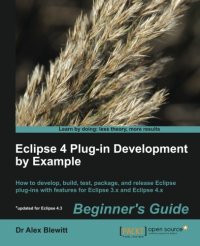
Ebook: Eclipse 4 Plug-in Development by Example: Beginner's Guide
Author: Dr Alex Blewitt
- Genre: Computers
- Tags: Библиотека, Компьютерная литература
- Year: 2013
- Publisher: Packt Publishing
- Language: English
- epub
How to develop, build, test, package, and release Eclipse plug-ins with features for Eclipse 3.x and Eclipse 4.x
Overview
- Create plug-ins to extend the Eclipse runtime covering Eclipse 3.x and the changes required for Eclipse 4.x
- Plug-ins from design to distribution — wide coverage of the entire process
- No prior OSGi or Eclipse plug-in development experience necessary
In Detail
As a highly extensible platform, Eclipse is used by everyone from independent software developers to NASA. Key to this is Eclipse’s plug-in ecosystem, which allows applications to be developed in a modular architecture and extended through its use of plug-ins and features.
"Eclipse Plugin Development by Example: Beginner's Guide" takes the reader through the full journey of plug-in development, starting with an introduction to Eclipse plug-ins, continued through packaging and culminating in automated testing and deployment. The example code provides simple snippets which can be developed and extended to get you going quickly.
This book covers basics of plug-in development, creating user interfaces with both SWT and JFace, and interacting with the user and execution of long-running tasks in the background.
Example-based tasks such as creating and working with preferences and advanced tasks such as well as working with Eclipse’s files and resources. A specific chapter on the differences between Eclipse 3.x and Eclipse 4.x presents a detailed view of the changes needed by applications and plug-ins upgrading to the new model. Finally, the book concludes on how to package plug-ins into update sites, and build and test them automatically.
What you will learn from this book
- How to create plug-ins for Eclipse 3.x and 4.x and automatically test plug-ins with JUnit
- How to display tree and table information in views
- What are the specific differences between the Eclipse 3.x model and the Eclipse 4.x model
- How and when to build user interfaces from SWT and JFace
- How to run tasks in the background and update the user interface asynchronously
- How to build plug-ins, features and update sites with Maven Tycho and automate user interface tests with SWTBot
- How to store and obtain preferences, and how to integrate with the Preferences panel
- How to work with the Eclipse resources model for creating and updating files and reporting errors to the user
Approach
A Beginner's Guide following the "by Example" approach. There will be 5-8 major examples that will be used in the book to develop advanced plugins with the Eclipse IDE.
Who this book is written for
This book is for Java developers who are familiar with Eclipse as a Java IDE and are interested in learning how to develop plug-ins for Eclipse. No prior knowledge of Eclipse plug-in development or OSGi is necessary, although you are expected to know how to create, run, and debug Java programs in Eclipse.